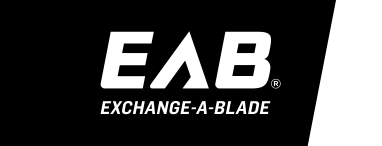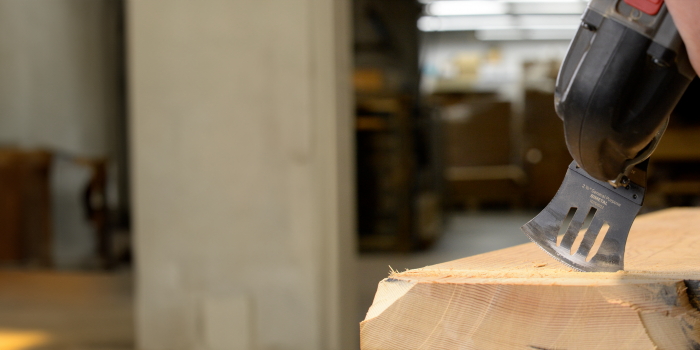How to choose the right saw blade for my job from the hundreds of options?
2017/04/28
Ever wondered why there are so many varieties of saw blades to choose from?
It can be confusing. If all you need to do is make a single, rough cut in a piece of wood, then any blade will do. But most of us want to make numerous, high-quality cuts in a variety of materials. That’s why EAB has over 140 unique blades to choose from, each one designed to produce optimal results for the job at hand.
Here’s the ‘must-knows’ to help you choose the right blade as well as some key benefits to having a variety of blades at your disposal.
- Blade quality: A quality blade means a quality cut. EAB produces quality blades to cut virtually any material and fit any budget. Standards are high and blades undergo extensive testing in our lab to ensure consistent high quality. For light to medium duty work GEN (General Purpose) blades will certainly fill the need. PRO (Professional Series) is designed for the heavy-duty needs of the professional user or demanding DIYer. And IND (Industrial Series) is EAB’s highest quality line of blades, designed for the extreme duty needs of the commercial woodworker and contractor. Before you buy, determine whether you need GEN, IND, or PRO so you won’t be disappointed.
- Blade size: While this may seem obvious, you may be surprised to learn that each tool requires the right diameter blade to match cutting requirements and specific RPM (speed) of both the blade and saw. Using the wrong diameter blade and mismatching the RPM can result in equipment damage and operator injury. When selecting your blade, check your power tool requirements and the blade label carefully.
- Number of teeth: How many teeth should you have? It’s not a case of more is better. Too many teeth cause a slow cut and burning, while too few teeth will give a very rough and splintered cut. A good rule of thumb, regardless of the blade diameter or thickness of material, is to have 2 to 4 teeth in the material being cut. This will produce the smoothest cut, optimal chip removal, the least amount of friction, and less strain on your equipment. Most importantly, it’s also safer.

- It’s all in the teeth: The teeth are the critical feature of any saw blade. The teeth determine the type of materials the blade can cut, how fast or controlled your cut will be, how smooth your finished cut will appear, and how long your blade will last. All EAB blades are designed to achieve optimal results regardless of the type of blade.
- Carbide Grade or Type: The grade of carbide tooth will help determine the type of material to be cut and the expected life of a blade. You might think that a harder grade of carbide will hold its sharp edge longer and have a longer life. While this is true to a certain degree, it also depends on the sharpening and usage. Generally speaking, softer carbide tips are more shock resistant and while harder tips will hold an edge better, they’re more brittle. For example, C2 or C3 carbide blade tips are best for cutting wood and construction materials on job sites. C4 and C6 blade tips are best for cutting melamine, plastics and metal products.
- Hook Angle: The hook angle is the amount of forward or backward lean of each tooth. A higher hook angle will give you a more aggressive and faster-cutting speed, ideal for ripping and crosscutting lumber. A low (less than 5°) or negative hook angle will give a smoother, slower cut, which is ideal when cutting hard or brittle materials such as melamine and metal materials. While low hook angle blades are ideal for crosscutting with mitre saws, they are not ideally suited for ripping on table saws.

- Tooth Configuration or Shape: As with any cutting device, the shape or configuration of the cutting edge determines how well it will perform. The design of a blade’s teeth determines how well it will cut different materials and how long it will last.
 |
Alternate Top Bevel (ATB) ATB is the most common tooth configuration for cutting wood and wood-based materials. Teeth alternate between right and left-hand bevels, to alternately slice through the material’s fibers for fast, smooth cutting. |
 |
Alternate Top Bevel with Raker (ATBR) Found on our All-Purpose blades designed for both crosscutting and ripping. Teeth are arranged in groups of five — four ATB teeth and one flat top raker tooth — with a large gullet between the groups to remove larger chips when ripping. This configuration is also known as planer combination. |
 |
Triple Chip Grind (TCG) For cutting hard, solid materials such as MDF, plastics, laminates, and non-ferrous metals. Teeth alternate between a flat raker tooth and a higher chamfer tooth, which produce very clean cuts, though at a much slower feed rate |
 |
High Alternate Top Bevel (Hi-ATB) For extra-fine crosscutting and for materials prone to chipping, such as melamine. The high bevel accentuates the razor-sharp slicing action and provides a sandpaper smooth finish. |
 |
Poly Chrystaline Diamond (PCD) A carbide tip topped with a thin diamond coat, specifically designed for cutting fiber cement cladding products such as HardiePlank®. |
- Sharpening: Sharpening is the all-important final step in the production of a quality saw blade. All EAB blades go through a “complete sharpening” process, which means they are sharpened on the face, top and sides on computer controlled sharpening machines. These machines hone the tips to a mirror-like finish with 400, 650 and 1,000 grit diamond wheels. This means that the blade you buy has the best cutting edge, to provide you with optimal performance and long life.
EAB’s expansive selection of blades includes the right blade for every job and every budget. And its green exchange system saves you dollars. Find the right blade for your next job.





.jpg)
